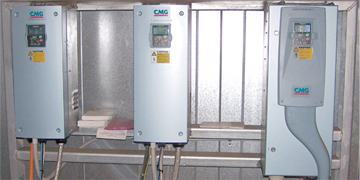
Vacon Drives, Coles Myer Mulgrave
Variable Speed Drives (VSDs) are now being widely used across the
HVAC industry in many different applications. The benefits of a VSD,
including their ability to regulate fan speed, save energy consumption
(up to 70% in some instances) and provide motor protection, are now
well recognised. However,
in certain applications a
number of possible issues
must also be considered.
This article looks at these
issues and provides
practical solutions that
may help ensure reliable,
trouble-free operation.
AC electrical power
emitted from the VSD
device will differ from
a normal AC supply in
the shape of the voltage
waveforms released. The waveforms from the output side of the VSD
are achieved with what is known as ‘Pulse Width Modulation’ (PWM),
which essentially turns the power on and off for a given period of time
several thousand times a second.
The PWM method of operation enables the VSD to have a limitless
number of operating speeds for an induction motor. However this can
also cause certain issues during operation which do not appear in fan
installations where normal mains AC is used.
Some of these are:
- VSD-induced motor noise
The ‘jagged’ nature of the waveforms sent to the motor by the VSD
device can cause some motors to produce vibration in tune with the
switching frequency of the VSD output. These vibrations are actually
harmonics in the motor windings which then excite the fan casing or
the ductwork attached to it. This as a result, creates noise.
The current generation of VSDs are available with filters which will
resolve this issue and reduce the noise output.
Alternatively, the switching frequency of the VSD output can be
changed. A drawback to this approach is a reduction in the power
handling of the VSD that ultimately limits how high this frequency can
be set. Setting the switching frequency of the VSD higher may produce
noise that is less audible, but this depends on what is practically
achievable with the motor and VSD combination.
- Voltage spikes
Momentary high voltage spikes can be
experienced at the motor terminals as a result of the voltage
output of the VSD. These spikes can be 4 to 5 times greater
than the peak AC voltage and can greatly reduce the lifespan
of the motor, particularly if the motor has very compact
electrical windings. The reason for this is that the high
voltages can try to arc between spots in the motor windings
where the insulation is thin, and compact windings with
thinner wire and thinner insulation are more susceptible to
this. Motors in an External Rotor (ER) configuration are a
good example of this, as the windings have to be extremely
compact to fit in this application.
This can be resolved using special filters such as dV/dT and
all-pole sinusoidal filters, which effectively ‘smooth out’ the
voltage waveforms from the VSD.
Another way of avoiding the problem is to aim for very short
wiring lengths between the VSD unit and the motor.
- EM interference from cables
The nature of voltage waveforms from a VSD can induce a lot
of Electro Magnetic (EM) interference. This may be reflected
in malfunctioning computer equipment, inconsistent sensor
readings in control systems or poor television and radio
reception. Using shielded cables between the VSD and
the motor will help to reduce this problem.
- Natural Frequency / Resonance Coupling
Another issue that can sometimes occur in variable speed
fan applications relates to a ‘natural frequency’ or ‘resonance
phenomenon’. All structures have a certain stiffness and will
deflect under applied load from either
its own weight or the weight of other
objects placed upon it.
This is simply known as a spring and
mass system.
This system also has a certain
‘resonance’ frequency that is a
characteristic of that system. If it is
then excited or vibrated at the same
frequency from another source, the
entire structure can start to deflect and
move enormously. For a spectacular
example of this look up the Tacoma
Narrows bridge. The catastrophic
vibrations that destroyed the bridge
was the result of a complicated oscillation between the
bridge and the winds passing through it.
An example can be the observation of a change in the
vibration or movement of a fan at certain speeds.
In the case of a variable speed fan installation, care must
be made so that the operating speeds of the fan do not
correlate with the natural frequencies of the mounts, building
structure or the fan itself.
Examples of how this can be achieved include:
-
-
Upgrading or resizing anti-vibration mounts
- Replacing or adjusting fan specifications including speeds
- Adding weight/mass to the structure
- Programming the VSD to avoid the resonant speeds
As you can see there are a number of issues that may arise
through the use of a VSD, but in many cases, potential
problems can be easily avoided or simple solutions put in
place, particularly if they are considered when selecting
equipment. VSDs are still an efficient and effective method
for programming fan speed, reducing energy consumption
and providing motor protection.
For assistance on VSD selection or technical advice, please call
your Fantech branch or agent.





